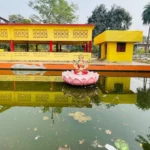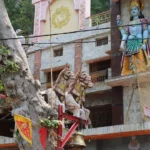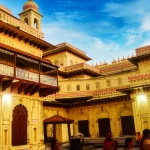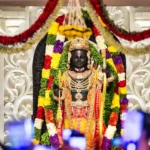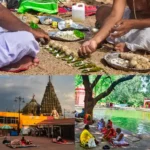Nageshwarnath Temple – Tourist Places in Ayodhya
Importance to Lord Shiva’s Devotees
Nageshwarnath Temple is dedicated to Lord Shiva, one of the principal deities in Hinduism known as the destroyer and transformer within the Trimurti. For devotees of Shiva, this temple is a sacred site that offers a deep spiritual connection with the deity. According to local beliefs, the temple was established by Kush, the son of Lord Rama, making it intrinsically linked to the legendary epic of the Ramayana.
This connection adds to the temple’s religious significance, attracting a multitude of Shiva worshippers, especially during auspicious occasions related to Lord Shiva.
Ancient Architecture
The architectural style of Nageshwarnath Temple is reflective of the traditional temple architecture prevalent in northern India. Although the temple has undergone renovations over the years, it retains elements that highlight ancient Indian craftsmanship.

The structure is characterized by its intricate carvings, ornate pillars, and a distinct Shikhara (spire) that rises above the sanctuary. The temple stands as a fine example of the harmonious blend of mythology, spirituality, and artistry that defines many of India’s ancient temples.
The Annual Shivratri Festival
The temple gains particular prominence during the annual Maha Shivratri festival, a celebration that marks the marriage of Lord Shiva and Goddess Parvati. Maha Shivratri is one of the most important festivals for Shiva devotees, and at Nageshwarnath Temple, the occasion is marked by elaborate rituals, prayers, and cultural events.
Devotees flock to the temple in large numbers to offer prayers, perform Poojas, and participate in the vibrant festivities that include bhajans (devotional songs) and kirtans (group singing). The temple and its surroundings are beautifully decorated, creating a festive and spiritual atmosphere that is both enthralling and sacred.
In summary, Nageshwarnath Temple is not just a religious site but also a cultural and architectural landmark in Ayodhya. Its significance to Lord Shiva’s devotees, coupled with its ancient architectural beauty and the fervour of the Shivratri festival, makes it a must-visit destination for both spiritual seekers and lovers of Indian heritage
Saryu Ghat – Tourist Places in Ayodhya
Tranquil Ambiance
The ambience of Saryu Ghat is one of peace and serenity. The gentle flow of the Saryu River, the soft rustling of leaves, and the distant sound of temple bells create a meditative atmosphere. As the sun rises and sets, the sky’s hues reflect beautifully on the river, providing a picturesque and soothing backdrop. This tranquil setting is ideal for contemplation and spiritual rejuvenation, making it a favourite spot for those seeking a break from the hustle and bustle of daily life.
Spiritual Activities
Saryu Ghat is a hub of spiritual activities. It is common to see devotees performing ritual baths (snan) in the river, believed to purify the soul and wash away sins. Many pilgrims also conduct ‘aarti’ and ‘puja’ along the ghats, offering prayers and seeking blessings.

The ghat resonates with the chants and hymns, adding to the spiritual aura. During auspicious days and festivals, the ghat becomes a vibrant centre of religious ceremonies and rituals, drawing thousands of devotees.
Boat Ride on the Saryu River
One of the most serene experiences at Saryu Ghat is taking a boat ride on the river. These rides offer a unique perspective of the ghats and the city of Ayodhya. As you glide over the waters, the view of the skyline dotted with temples and minarets, coupled with the calmness of the river, creates a memorable experience. A boat ride during sunrise or sunset is particularly recommended, as the sky’s changing colours provide a breathtaking vista.
Reflection and Connection
Visitors to Saryu Ghat often find themselves immersed in an experience that goes beyond mere sightseeing. The ghat offers a space for reflection and a deeper connection with one’s spiritual self. It’s a place where the sacredness of Ayodhya is most palpable, making it a must-visit for those exploring the spiritual dimensions of this ancient city.
In summary, Saryu Ghat in Ayodhya is more than just a scenic spot; it’s a spiritual retreat that offers tranquillity, a deep connection with religious traditions, and a chance to experience the holy river’s calming presence. Whether through participating in spiritual activities, enjoying a peaceful boat ride, or simply soaking in the serene atmosphere, a visit to Saryu Ghat is a soul-enriching experience
Tulsi Smarak Bhawan – Tourist Places in Ayodhya
Dedication to Goswami Tulsidas and the Ramcharitmanas
Tulsi Smarak Bhawan serves as a tribute to Tulsidas, whose “Ramcharitmanas” is considered one of the greatest works of Hindi literature. This epic poem, written in Awadhi, a dialect of Hindi, retells the story of the Ramayana, depicting the life and virtues of Lord Rama.
Tulsidas’ work has had a profound influence on Indian culture and spirituality, making his legacy an integral part of Ayodhya’s heritage. The Smarak Bhawan celebrates his contributions, showcasing his life and works, and serving as a reminder of his enduring spiritual and literary significance.
The Ayodhya Research Sansthan
Within the premises of Tulsi Smarak Bhawan is the Ayodhya Research Sansthan, a centre dedicated to the study and research of the cultural heritage, literature, and spiritual traditions of Ayodhya.

The institute conducts scholarly research, organizes seminars, and publishes works related to Ayodhya’s history and its association with the Ramayana. It also houses a rich collection of manuscripts, documents, and works of art that offer insights into the region’s historical and cultural narratives.
Cultural Events and Activities
Tulsi Smarak Bhawan is not just a memorial; it’s a vibrant centre for cultural activities and events. Regular recitations of the “Ramcharitmanas” are held here, along with performances of Ramleela, which depict scenes from the Ramayana.
The centre also organizes various cultural programs, exhibitions, and lectures that attract scholars, devotees, and tourists. These events serve to promote the teachings of Tulsidas and the values embodied in the Ramcharitmanas, fostering a sense of cultural continuity and spiritual introspection.
Conclusion
Tulsi Smarak Bhawan stands as a beacon of Ayodhya’s rich literary and spiritual heritage. It offers visitors an opportunity to delve into the world of Tulsidas and the Ramcharitmanas, while also engaging with the broader cultural and historical context of Ayodhya.
Whether for scholarly research, cultural immersion, or spiritual enrichment, Tulsi Smarak Bhawan is a key destination in Ayodhya that beautifully melds the past with the present.
Gulab Bari – Tourist Places in Ayodhya
Architectural Blend of Mughal and Awadhi Styles
Gulab Bari showcases a stunning fusion of Mughal and Awadhi architectural styles. This architectural synthesis is evident in its elegant domes, intricate floral designs, and the overall layout of the complex.
The Mughal influence is seen in the symmetrical designs and the use of domes and minarets, while the Awadhi style is reflected in the intricate detailing and the more indigenous patterns used in the structure. The mausoleum within the complex, with its fine detailing and ornamental work, stands as a testament to the craftsmanship and aesthetic sensibilities of the era.
The Rose Gardens
True to its name, Gulab Bari is surrounded by lush rose gardens, which add to its beauty and serenity. The gardens are meticulously maintained, featuring a variety of roses and other flowers, creating a vibrant and fragrant environment.

The blooming roses provide a picturesque backdrop to the historical structure, making it a popular site for visitors and photography enthusiasts. The gardens also serve as a tranquil retreat, offering a peaceful respite from the city’s bustle.
Historical Significance
Gulab Bari holds significant historical importance as it houses the mausoleum of Nawab Shuja-ud-Daula, the third Nawab of Faizabad. Nawab Shuja-ud-Daula was a key figure in the history of the region, and his mausoleum is a major historical site.
The complex not only commemorates his legacy but also serves as a reminder of the Nawabi era’s opulence and cultural richness. The mausoleum is revered and visited by many, reflecting the Nawab’s enduring influence on the region’s history and culture.
Conclusion
Gulab Bari stands as a unique historical and architectural marvel in Ayodhya. Its blend of Mughal and Awadhi architecture, coupled with the enchanting rose gardens, makes it a must-visit destination for those interested in history, architecture, and natural beauty.
The site offers a glimpse into the past’s grandeur while providing a serene and picturesque environment.
Tourist Places – Tourist Places in Ayodhya
Dining
Ayodhya offers a variety of dining options, ranging from local street food to more formal restaurants. You can enjoy traditional North Indian cuisine, which includes a variety of vegetarian dishes. Be sure to try local specialities and sweets, which are a staple in Ayodhya’s cuisine.
Nearby Landmarks
For sightseeing, you can explore the many temples, ghats, and historical sites within proximity to these accommodations. Each location provides a unique glimpse into the city’s rich cultural and spiritual heritage.
Remember, the best time to visit Ayodhya is typically from October to March, as the weather is more pleasant during these months.
For further details on accommodations and other tourist information, you can visit our website www.prayagsamagam.com which provides comprehensive guides on Ayodhya.











